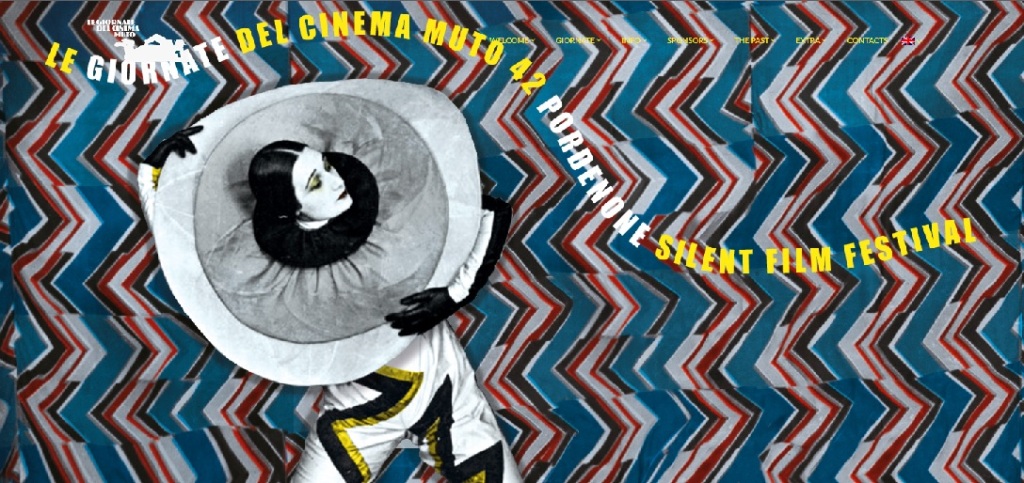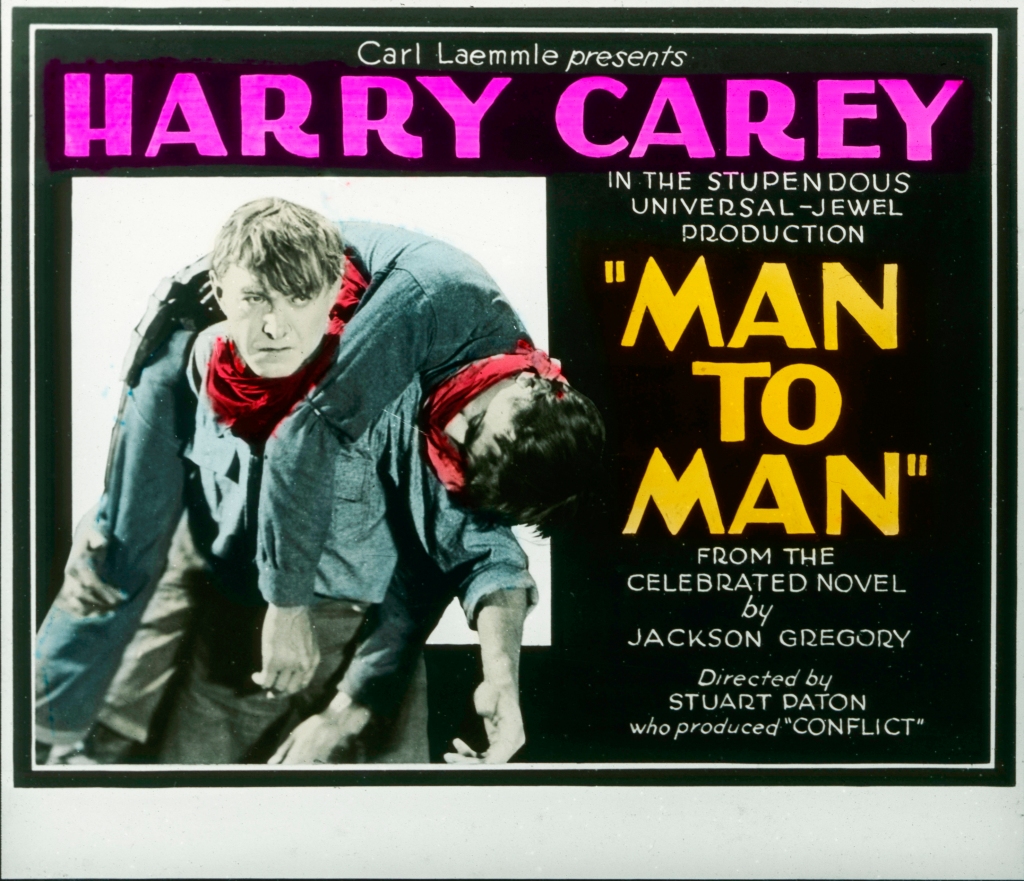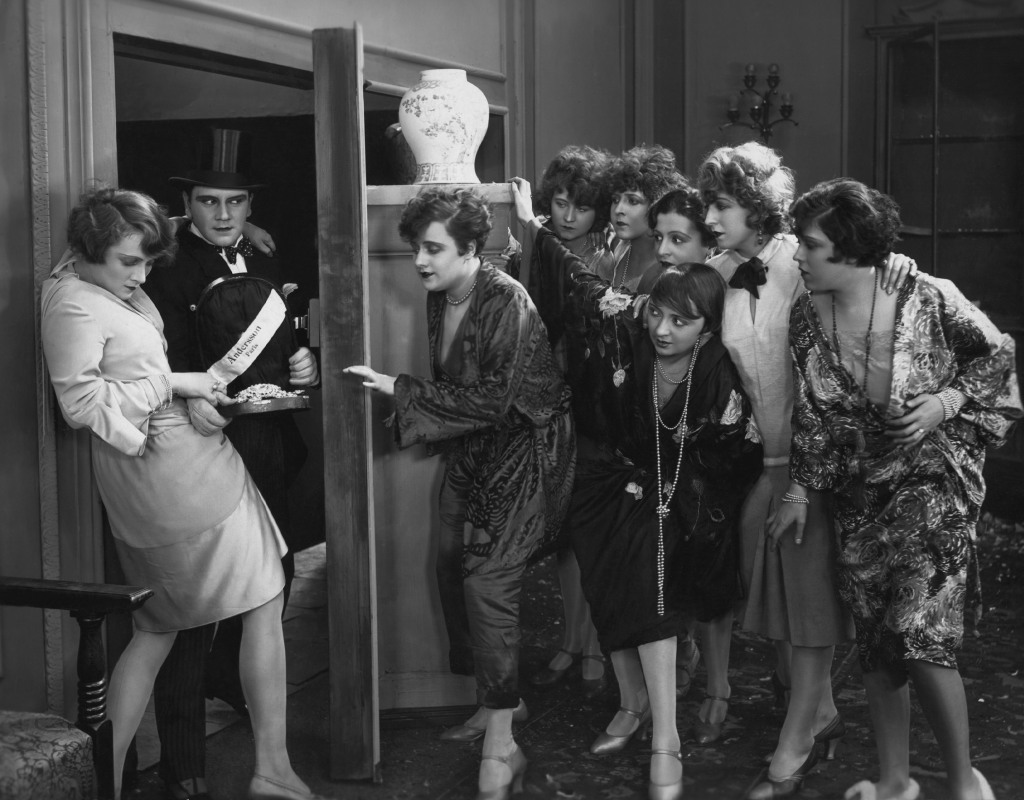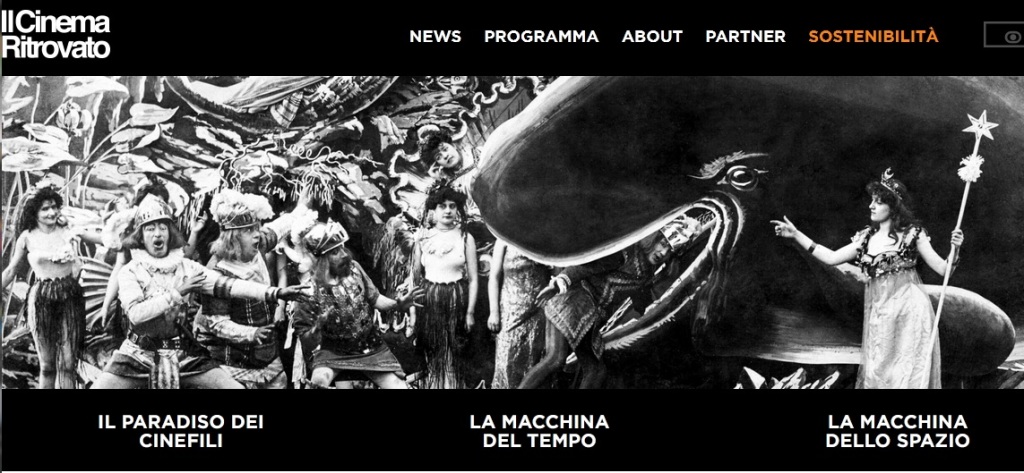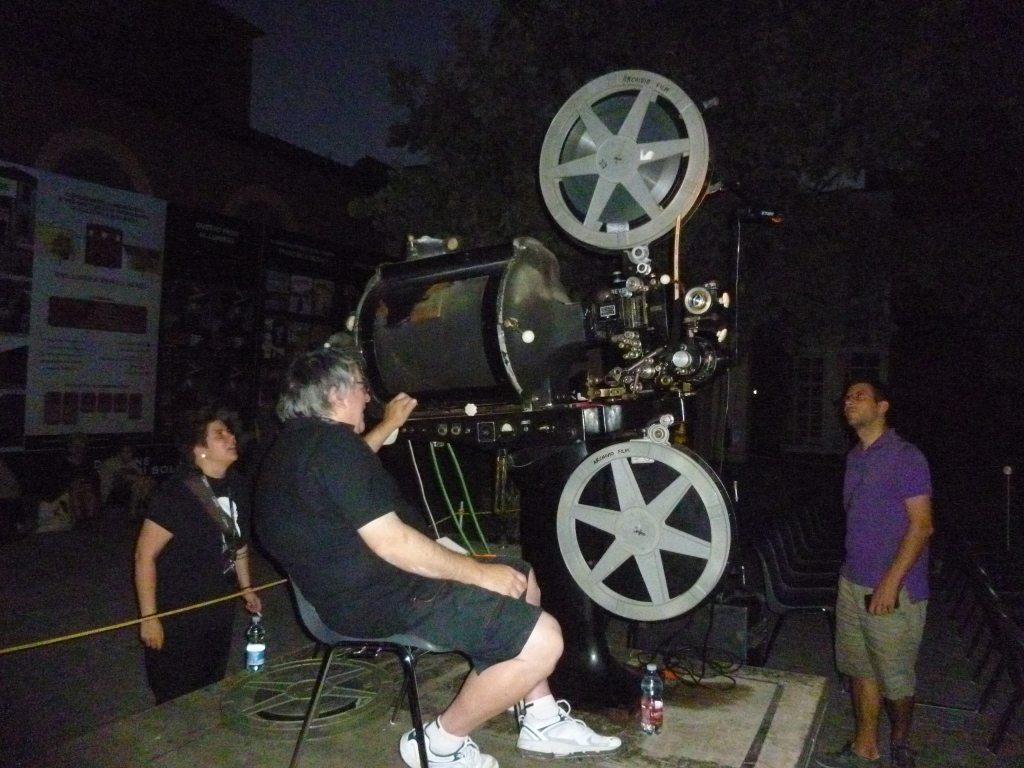
The weekend this year ran from Friday May 3rd to Sunday May 5th. We missed out on a Thursday night treat as the George Eastman Museum was celebrating Julia Roberts and [I am pretty sure] she was never filmed on nitrate. Prior to the weekend, in a first, a cryptic pitch from the Museum hinted at some of the delights:
“There will be at least one Academy Award Winner for Best Picture
A film directed by Alfred Hitchcock
Jon Barrymore will be present on our silver screen
And, we’ll have every genre from mysteries and romance to westerns and film noir to comedy and cartoons! “
On our journey down we produced a list of potential titles. The only success was the Hitchcock title which Peter Rist had seen before and which he knew was a print at the Museum
The programme was announced Friday morning at 8.45 a.m. We were still enjoying a fine breakfast before walking up to collect a programme. Initially I wondered whether this would be a good year but it turned out to be excellent, with both interesting and entertaining films and generally good quality prints. We had enough time to walk in to town and visit the Greenwood Bookshop, a recommended stop for anyone visiting Rochester. We fortunately also had time to visit the Memorial Museum of Fine Art. This featured an installation by Isaac Julien celebrating Frederick Douglas. Douglas is buried in the city. This was a splendid feature. Ten screens, of varying sizes, displayed video films dramatising important events in the life of Douglas. It was very well set out; one could follow key screens and still be aware of the other screens and how the representations moved around these. I only had time for one viewing, [it runs half-an-hour], so I hope it will be seen in Britain at some point.
Friday afternoon started with two talks in the series ‘Keepers of the Frame’. David Russell from the Imperial War Museum delved into the history of that Institution and his own archival experiences to offer insights in to working with nitrate, especially the most important issue of preservation. He downplayed the hazards of the format though he stressed the problems of finding and keeping good copies. Elaine Burroughs followed presenting the James Card Memorial Lecture. She talked about her experiences at the British Film Institute and also with FIAF [International Federation of Film Archives]. She had some startling clips illustrating nitrate’s inflammability. So we enjoyed ‘Mr Ice’ and M/s Fire’; rather like the bout in The Black Dahlia (20026).
The programme of films followed the patterns set in earlier years. So the first session was devoted to shorts.
Battle of Midway (USA 1942), an 18 minute colour print from the Museum of Modern Art in New York. Shot on 16mm Kodachrome it was released in a 35mm Technicolor print. Commander [John] Ford supervised the filming. And well known actors, Ray Milland, Donald Crisp and Jane Darwell read the commentary. This is very much from the US side though it shows the casualties and wreckage of the US forces. There is some fine aerial cinematography. But the tone, as is the wont in US war movies, is stentorian.
Swooner Crooner, (USA 1944), was one of several colour animations, this by Frank Tashlin. This was also from the Museum of Modern Art. Running seven minutes it shows a battery of hens being encouraged to increase egg production. The hens are clearly stand-ins for the female work force in World War II, demonstrating the changes in representations between then and now.
Tulips Shall Grow was another war-time colour animation, (USA 1942), this time from the hand of George Pals. The print and the Technicolor were in fine condition , in a Library of Congress print. The plot involves a young Dutch couple who suffer when the ‘army of Screwballs’ invade. But ‘Mother Nature’ provides a catalyst for resistance and victory over the invaders. These were cartoon variations on thinly disguised allies and Nazis.

‘When Tulips Bloom’
Looking at London (USA 1946). This was a Fitzpatrick Travel Talk, running 10 minutes and in Technicolor, also from the Library of Congress. The film presents London post-war including the effects of the German bombing campaigns. Somewhat scratched the film seems rather bland compared with the documentaries and newsreel from the war years.
Gardens of the Sea (USA 1947) and Landscape of the Norse (USA 1947) , both from the Academy Film Archive, were both documentaries studying places overseas; not one of the strongest suits of US cinema. The Australian coral reefs look good in the title’s Cinecolor and are a pleasure. The exploration of Norway picks up when the film travels to the northern reaches of the country. Both prints were from the Academy Film Archive,.
The Cobweb Hotel (USA 1936) was a delightful animation in colour from David Fleischer provided by the UCLA Film and Television Archive. The sardonic tone as flies battle to escape the malevolent designs of a spider are very entertaining.
Finally The Temperamental Lion (USA 1939) was a colour animation which offered rather conventional plotting. It has been preserved by the Chicago Film Society. Unfortunately it seemed to be a warped print which meant that the focus came and went. This last screening demonstrated the ageing faults that the projection team had to tackle in presenting the titles. All had some level of shrinkage and several had suffered damage to the edges and sprocket holes.
The evening meal break offered both the excellent Museum bar and [an innovation from 2018] food wagons by the entrance. If you were energetic you could also walk to a nearby restaurant, though these are at least ten minutes or more away.
The early evening programme was Luis Buñuel’s L’Age d’Or (1930). The screening was from a George Eastman print which they acquired from the legendary Henri Langlois and it was in reasonable condition. This is an undoubted classic and a fine example of surrealist film. It is longer and more complex than Un Chien Andalu (1929), partly because it has both title cards and recorded dialogue, plus recorded music and effects. Sex, violence, satire, subversion and sardonic humour engage one for just over an hour. I especially like the giraffe flying out a window, the cow on the bed, and a familiar figure with hitherto suppressed biography. The Catalogue recorded the disruptions to the original screening and also a fine example of right wing anger and bile:
“All those who have safeguarded the grandeur that is France, all those, even if they are atheists, who respect religion, all those who honour family life and hold childhood sacred, all those who have faith in a race which has enlightened the world , all those sons of France whom you have chosen to defend you against the moral poison of unworthy spectacles appeal to you now to uphold the rights of the censor.” (In ‘Le Figaro’, December 13, 1930).
If I did not already know the film I would have rush to see it.

The evening ended with The Beautiful Blonde From Bashful Bend (1949). This was the last major title directed by Preston Sturges in Hollywood. The print from the Museum of Modern Art was in good shape and the Technicolor format offered bold and vivid colours. The ‘Blonde’ (Betty Grable) is a western ‘sure shot’ whose main problem is her unfaithful boyfriend Blackie (Caesar Romero). The action tends to slapstick but is done with real panache. The climatic sequence is a lengthy gun battle full of witty visuals. The audience went to bed full of humour.
Saturday morning opened with the 1947 Nightmare Alley. This was a print from the UCLA Film and Television Archive. It was a pleasure to watch:
“The blacks are saturated to give the eerie feeling of night shadows and life on the dark side.”
Generally seen as a film noir the film lacks the flashbacks and confessional mode of the genre. And the femme fatale in this story is an overweening ambition embodied in fake spiritualist Stanton ‘Stan’ (Tyrone Power). In 2018 we had a fine Tyrone Power film, The Razor’s Edge (1946) adapted from the novel by Somerset Maugham. Both these films were directed by Edmund Goulding, a Hollywood talent that deserves greater recognition. This film also has fine black and white cinematography by Lee Garmes. The ‘Variety’ review (October 15, 1947)commented
“Despite the grim realism of its treatment, it has all the shuddery effect of a horror yarn”

The afternoon started with a short film by Arne Sucksdorff from the Swedish Film Institute / Svenska Film Institute, Strandhugg (‘Forays’, 1950). The print was in excellent shape and Sucksdorff’s films offer fine black and white cinematography. Two earlier Picture Show were graced by his work and this 15 minute film offers poetic sequences of the seaside.
The feature in this session came from the National Audiovisual Institute of Finland / Kansallinen audiovisualinen institutti: People of the Summer Night / Ihmiset suviyössä (1948) was directed by Valentin Vaala. Vaala made 44 films in a long career but this is reckoned to be his finest. It is adapted from a novel by Frans Eemil Sillanpää’s (1934). Set over one night in a small rural community we watch various relationships and actions among local people; these include birth, death, and conflicts fuelled by alcohol. There also seems to be a implicit gay character. The cinematography by Eino Heino is excellent. The film offers a ‘warm-hearted and sensitive’ evocation of the ordinary but compressed for dramatic purposes.
Late afternoon offered a Cinecolor western, The Nevadan (1950). Cinecolor was a two colour subtraction system, cheaper and quicker to process than Technicolor. Not that many features were filmed in the process which offered especially vibrant orange, red, blue and green.
“Ruggedness and realism, plus the employment of Cinecolor photography, have established several cuts above average westerns the sagebrush sagas produced by Harry Joe Brown and starring Randolph Scott.” (‘Boxoffice’, January 14 1950).
This is typical Scott hero. Upright and stalwart, as he outmanoeuvres and outguns the villains led by George Macready. And there is the young Dorothy Malone, not just a romantic interest, but involved in the action. The print from the Austrian Film Museum had quite a lot of scratches and noticeable splices but the colour was excellent.
Rebecca (1940) ticked an Academy Award winner, a Hitchcock film and a mystery movie. This was a George Eastman print in pretty good condition. There is some fine cinematography by George Barnes and a great score by Franz Waxman. I find that the first part of the film is really good as we encounter [through the eyes and ears of the unnamed heroine) the titular dead character. But once the past is revealed I think the film becomes less interesting and dynamic. The screening included a set of screen tests. Those with Joan Fontaine wearing possible costumes were poor; she had a high temperature and the costumes were clearly inappropriate. But the following two, with Nova Pilbeam and Anne Baxter, demonstrated how apt was the casting of John Fontaine.
The Sunday opened with a classic film noir, Dead Reckoning (1947). This was a Library of Congress print with signs of wear, both on the emulsion and on the sound track. However, it still showed off the qualities of this black and white film. The movie has all the characteristics of a noir thriller; the confessional mode, flashbacks, the world of chaos into which the hero falls, night and chiaroscuro and a femme fatale. But I did not find it had a strong noir feel. This is mainly because the fatale, ‘Dusty’ (Lizabeth Scott] seems more like the scheming female of private eye films such as The Maltese Falcon (1941). And Humphrey Bogart’s ‘Rip’ is in the mould of the same private eye.

The afternoon offered a John Barrymore film, Counsellor at Law (1933), finely directed in an adaptation from Elmer Rice’s play by William Wyler. The print was from the UCLA Film and Television Archives in very good condition. The early sound track apparently needed adjustment from time to time by the projectionists. Rice was Jewish, a socialist and had legal training; all of which fed into the play and the film. Rice also wrote the screenplay and apparently Wyler referred frequently to the original play during production. Barrymore is excellent as a shyster Lawyer George Simon, originally from the Jewish Lower East Side of Manhattan. The film [and play] follow his Machiavellian manoeuvres when a past case returns to haunt him. The pace and the dialogue are crisp and sharp; Isabel Jewell as telephonist Bessie is a delight. And there is one memorable scene when Simon agrees to defend the son of an old Jewish neighbour, Harry Becker (Vincent Sherman). Harry is a communist and in a terrific sequence turns on Simon who he denounces as a class traitor. Even though this is pre-code Harry later dies from injuries sustained from the New York police. Sherman was a target of HUAC in the 1950s, suspected of real-life communism.
Then to Blind Date. I find the mystery rather coy but this year the title was worth a wait, Gone to Earth (1950). The clue was a shot of the wedding cake after Hazel’s (Jennifer Jones) marriage to the Reverend Edward Marston (Cyril Cusack). In the adaptation of a novel by Mary Webb Hazel,
“as she races barefoot across the Shropshire fields, her hair streaming behind her, like some mystic being from a quaint old folk tale …..” (‘Picture goer’ October 21, 1950)
is caught between the religious but liberal Edward and the sexy but brutal Squire ‘Jack’ (David Farrar). Rather than a triangle this is a square, including Foxy, a young vixen [unfortunate not credited]. Jennifer Jones is miscast as this wild country spirit but she gives her performance real panache. Cusack is grave and convincing and Farrar probably had the female audience swooning with desire. Hugh Griffith watches balefully in an oddly bizarre performance as Andrew Vessons, manservant.

‘Whose cake?’
The print was from the George Eastman Museum, a donation by the Selznick family. Fortunately it was the British print not the shorter US version titled The Wild Heart. Watching it fitted the comment in ‘The Spectator’ (September 29, 1950);
“Beautifully coloured, it is as lively a film to look at as I have ever seen, and when the direction deigns to be mobile it is infinitely rewarding.”
The directors were those idiosyncratic romantics, Michael Powell and Emeric Pressburger.
So this was a rewarding weekend filled full of cinematic pleasures. The organisers and volunteers got a deserved ovation at one point. And, in a habit that is distinctive to George Eastman, the audience were also invited to applaud the projectionists who work overtime to presents these old and often delicate prints. One of the problems they encounter is the shrinkage of prints, a standard difficulty with nitrate. It is reckoned that once pass 1% screening becomes really difficult. However, two of the best looking titles of the Weekend, Strandhugg and Gone to Earth, both had 1.05%. I have noted the origins of the prints and many of these were introduced by members of the particular archive. We also had introduction from George Eastman staff. In previous years speakers have focussed on the history of the print in question. This year they tended to talk about the ‘values of ‘reel’ screenings’; I do prefer the print detail.

Punters who would like to see a whole programme of the original cinema format should note that next year the Picture Show Weekend is later, June 4th to 7th 2020. We were advised that Yuri Tsivian is on a mission for the Museum scouring European Archives for Nitrate Prints. Perhaps Sergei Eisenstein, Max Ophuls or Jean Renoir?
